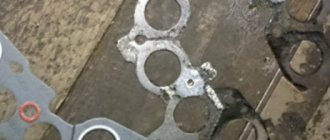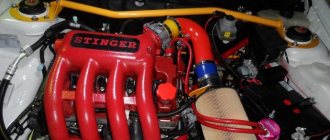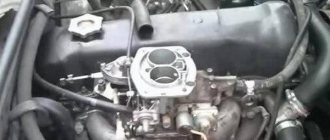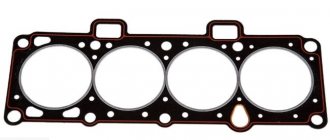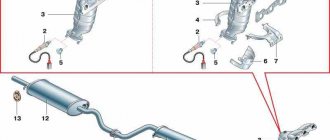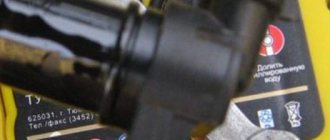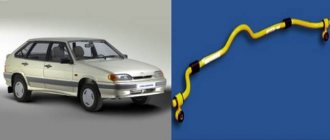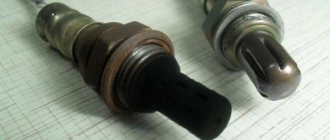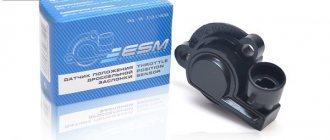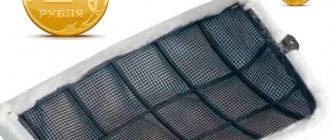Replacing the exhaust manifold and gasket on a VAZ 2114
The exhaust manifold is a unit that is responsible for ride quality, without which comfort is impossible. This is silence and the absence of exhaust smell under the hood, which can be drawn into the cabin through the hole in the cabin filter. Fixing a leak in the exhaust manifold of a VAZ 2114 is a necessary repair. Fortunately, it is not urgent; you can prepare in advance and choose a convenient moment.
Exhaust manifold for VAZ 2114
Types of manifold pipe layouts
Exhaust manifold with 4-1 layout. It consists of four pipe-channels connected into one common pipe (the number of channels corresponds to the number of cylinders).
Exhaust manifold 4-2-1. In such collectors, pipes first connect cylinders operating in pairs (on the same stroke), and then move into one common pipe.
An important parameter of exhaust manifolds is their length, and, accordingly, their volume. If the length of the exhaust channels is insufficient, the energy of the exhaust gas flows will be enough to enter the channels of adjacent cylinders and negatively affect their operation. In such collectors, the wave movements of gases are poorly synchronized with the operation of the engine. At the same time, engines with a short exhaust manifold typically have “narrow” valve timing with a relatively small volume of exhaust gases. The production of short-length collectors is justified by low cost.
Long exhaust manifolds are used on powerful and efficient engines. In such manifolds, part of the volume of exhaust gases flows through a common pipe into the next components of the exhaust system, and part is “reflected” to the remaining cylinders. It will take much longer for the wave to pass from one cylinder to another, which creates definitely better conditions for discharge and purging.
Exhaust manifold with equal length exhaust pipes (equal length). Typically installed on powerful sports cars.
An equal-length manifold allows for uniform exhaust in all cylinders and better synchronizes the operation of the engine with the exhaust system. Tuning the exhaust tract can be done on any engine. This is guaranteed to bring an additional 3-5% power.
Do not forget that increasing the length of the exhaust manifold will also entail an increase in temperature in the engine compartment.
The temperature problem is solved by installing thermal insulation. To do this, you can use a metal casing or a special non-flammable fabric.
There are models of collectors in which ceramic coating is used as thermal insulation.
When is it necessary to replace and remove the exhaust manifold on a VAZ-2114
Huge temperature changes are the main problem faced by the exhaust manifold and the gasket, for which it is removed. The collector itself is made of a special grade of cast iron; it can withstand high temperatures (up to 800-900 degrees) , however, these are critical values, after which the collector may warp or crack.
Exhaust manifold VAZ-2114
Its main task is to collect exhaust gases and distribute them into the exhaust pipe of the muffler.
Replacing or dismantling the VAZ-2114 exhaust manifold is necessary in the following cases:
- Mechanical damage to the collector.
- Warping and loss of tightness at the junction with the cylinder head.
- Burnout of the gasket between the head and the manifold.
- The appearance of cracks as a result of engine overheating.
- Replacing the collector with a device of a different configuration, adapted to a more severe operating mode.
In the event that we are not going to participate in high-speed races for the prize of the head of the regional traffic police, replacing or dismantling the collector may be necessary in a number of cases.
Tools and materials for dismantling
There are a number of symptoms that will indicate that you need to prepare to remove the exhaust manifold:
- increased noise level in the engine compartment , the engine produces a characteristic, loud sound in any operating mode;
- breakthrough of exhaust gases into the engine compartment and sometimes into the cabin;
- reduction in engine power due to a mismatch between the exhaust gas outlets in the cylinder head and in the manifold.
Many people decide to replace the standard manifold with a “tuning” one, made of stainless steel and having a different configuration, thereby wanting to increase engine power and reduce the resistance that the standard manifold provides to exhaust gases. As a rule, the most common reason for dismantling a unit is gasket burnout .
Exhaust manifold gasket
The manifold gasket on the VAZ-2114 is made of pressed reinforced asbestos and is designed to ensure a tight connection between the block head and the manifold flanges. Asbestos is used to correct the coefficient of thermal expansion of the aluminum alloy from which the head is cast and the cast iron from which the manifold is cast. At high speeds and under prolonged loads, the gasket may burn out. Then its replacement and dismantling of the collector are inevitable.
To dismantle the manifold, you will need a standard set of tools, a set of sockets with extensions, and WD-40 penetrating lubricant or its equivalent. In case of broken studs, a stud extractor, drill, drill bits and a set of taps will be useful. A day or two before dismantling the collector, it is worth moistening all the fasteners several times, this will significantly simplify the removal procedure .
Welding exhaust manifolds with your own hands: features and recommendations
We figured out the essence of the problem and its possible causes. Now let's solve the issue of repairing the exhaust manifold. The only solution to the problem is welding. The design of the part itself does not provide for the occurrence of other problems other than through holes or cracks due to high temperatures and the influence of aggressive substances. The second solution is to replace the collector with a new one yourself or at a service station.
Welding aluminum using an electrode
1) How to remove/install the exhaust manifold in a car?
Depending on the degree of complexity of the repair, it may be necessary to purchase a new manifold, because welding will cost the same price, and sometimes even more. For most owners, it will be easier to contact a service station, but there is also a category of motorists who prefer to carry out minor repairs with their own hands.
A set of tools for replacing an old collector with a new one:
- a container into which you can drain the cooling liquid;
- manual/hydraulic/pneumatic or any other jack;
- a set of open-end, box and socket keys;
- ratchet wrench + set of attachments + extension;
- flat head screwdriver and cross head.
When buying a new manifold, you immediately need to change 2 types of gaskets in the kit - in the combination of the manifold/cylinder head and the manifold/receiver pipe of the exhaust system. The marking of the old one will tell you which collector to buy + consult the seller - this is sacred.
Algorithm for replacing the exhaust manifold:
- We first study safety precautions when repairing the propulsion system of vehicles.
- Turn off the battery.
- Drain the cooling liquid. To do this, you will need rubber gloves, wrenches, clean water and a container for draining (a regular basin will do).
- Depending on the presence of a carburetor, it may be necessary to remove the injector receiver. The second part to dismantle is the air filter.
- We take a suitable wrench and unscrew the nuts/bolts at the points where the manifold is attached to the cylinder heads. If we are talking about eight valve engines, you will have to first remove the intake manifold, then only the exhaust, because in such systems the fastenings apply to both types of parts.
- We are cleaning the plane of the cylinder heads from the remnants of the previous gasket. In case of significant blockages, you can use sandpaper or a file.
- Sometimes you have to restore the threads or install new studs that will secure the manifold.
- We install new gaskets.
- We are installing a new intake manifold. If this is an eight-valve engine, then in parallel we install the intake manifold, which was removed before.
- We tighten the bolts and nuts on the cylinder head.
- We connect the manifold to the exhaust system pipes and install a new gasket. We do not tighten the nuts and bolts completely.
- We check the correct installation of parts and accompanying gaskets and tighten the bolts and nuts.
- We filter the radiator and fill it with new cooling fluid.
- We connect the battery.
Only 14 steps. The entire process can take from 1 to 3 hours. Of course, if a person is okay with straightness of hands. If you are not confident in your abilities, it is better to contact a service center. More expensive, but better quality.
2) How are cast iron exhaust manifolds welded?
Before starting work, you need to decide what material the exhaust manifold is made of. There are 2 options here - cast iron or by welding pipes made of steel alloys with impurities to prevent corrosive processes. Cast iron parts are more common within the Russian Federation, so the bulk of further explanations will be about them. Welding methods when working with cast iron:
- Hot technology. When the workpiece is heated to a peak temperature of 600 to 660 degrees;
- Semi-hot technology. The welding process takes place at temperature conditions of 300-350 degrees Celsius;
- Cold technology. Welding is carried out under standard conditions, without any heating.
The last option differs in the method of laying seams - short sections on which repeated layers are applied. This approach avoids warping of the exhaust manifold material.
Classification of welding types
| Type | Peculiarities | Popularity (out of 5 ★) |
| Gas | The technique shows some of the best results when working with cast iron. Large carbon burnout is prevented without loss of quality in the seams. | ★★★★ |
| Semi-automatic | One of the conditions for success is high-quality preparation of the part for welding. It is important to remember the order of actions during the process. The additive will be specialized variations of the wire. | ★★★ |
| TIG welding | Manual welding using a non-consumable tungsten-based electrode, where argon is used as a shielding gas. The technique is quite acceptable for processing cast iron. | ★★★★ |
| Inverter | A type of manual welding with a large amount of preliminary work associated with cleaning the surface of the exhaust manifold welding site, degreasing and deepening the crack to a cone-shaped joint. The process itself occurs in layers with support as steel pins. | ★★★★★ |
If we are talking about working at home, then the only acceptable option is cold welding with an inverter. Due to the fragility of cast iron, laymen will not be able to properly repair even a small crack.
What is MIG and MAG welding
Which electrodes to use:
- OZCH 2 or 6. Electrodes based on a copper rod coated with iron powder;
- iron + nickel. Good electrode bundle for cast iron. Suitable for DC welding;
- iron + nickel + copper. The resulting seams can resist corrosive attacks and can come into contact with aggressive environments + hot gases without consequences.
If a crack is detected in the exhaust manifold, it is not advisable to wait until it leads to pipe failure. It is advised to remove the part from the engine as soon as possible and repair it. For cast iron collectors, welding requires an increase in carbon - from 3% to 7%.
If hot welding is used, the part must be preheated. The temperature is maintained at the same level (plus/minus 10%) throughout the entire welding process. Consider the physical properties of cast iron - the metal cools very quickly.
Due to the increased fluidity of cast iron, you can either drill holes along the crack or use graphite spacers, placing them under the welding site and also along the future seam. Pore formation during carbon burnout can distort the final result of the work, among other things, and therefore, be extremely careful during the work process.
3) Features of welding the stainless steel exhaust manifold
It already has its own characteristics. Depending on the alloy used in the assembly process of the exhaust manifold, the methods of welding the part may also change. Most elements contain an admixture of nickel, chromium and other non-ferrous metals, which complicates the process of sealing cracks and burnouts.
Please note: in order to avoid burnout of additives in stainless steel alloys, it is strongly recommended to weld parts exclusively in a shielding gas environment.
The secondary consequence is the deformation of the part due to the welding temperature. If the technology is fully followed, the flange will not need to be processed. Otherwise, we get seams with reduced anti-corrosion properties. The reason is overcoming the 500 degree mark. When the peak point is reached, the process of intercrystalline corrosion begins due to the redistribution of metal molecules inside the alloy.
Popular types of welding for stainless steel:
- general type inverter (TIG, AC) + inert medium + tungsten electrodes;
- manual type of welding using electrodes with a specialized type of coating;
- stainless steel wire + inert gas environment + semi-automatic welding.
If we are talking about a garage repair of a stainless steel exhaust manifold, the optimal solution would be to apply welding seams with MMA-coated electrodes. You can choose a titanium-based electrode with a rutile coating.
Less attractive options, but also working, are again titanium dioxide electrodes coated with calcium/magnesium carbonate. The thickness of the electrode is in accordance with GOST 10052.
Welding cast iron products with argon
One of the variations of welding a cast iron manifold with a welding machine:
4) Is it possible to cold weld the exhaust manifold?
Although cold welding is not directly related to metal welding of seams, some craftsmen still use it on a temporary basis. It is recommended to use the method only for those individuals who are familiar with the technology of execution.
When is it rational to use cold welding:
- if, when welding using the traditional method, the part is deformed;
- the geometry of your collector has a complex appearance, and the crack has appeared in the most inconvenient place where an electrode cannot be reached;
- the seam is located at the border of different metals.
To weld a stainless steel manifold, cold welding in the form of glue can still be used, but if the part is made of cast iron, you will only waste time. How long will a seam last? 500 kilometers at most, but in 80% of cases the welding flies off after 50-100 thousand meters, since, by the way, the seam does not work at all for shear and torsion.
To summarize, we note that the most rational welding of exhaust manifolds is an inverter with specialized electrodes for cast iron, and MMA welding with electrodes for stainless steel. Without experience in welding, be prepared for a lot of jambs and seam failures. If you want to save your nerves, it is better to contact a service station or replace the manifold altogether. Good luck on the roads!
Types of exhaust manifolds
All exhaust manifolds can be divided into solid and tubular. A one-piece exhaust manifold is typically a single piece cast from cast iron. The tubular manifold is made of welded pipes, steel and flanged connections to mate with the engine block.
Do-it-yourself manifold replacement + Video
If the collector is burnt out or covered with cracks, then there is no point in trying to weld it. The cost of such work will be several times higher than installing a new collector in a workshop. To replace the collector you will need:
- jack;
- basin for draining coolant;
- a set of open-end, box and socket wrenches;
- ratchet wrench with extension and a set of attachments of various lengths;
- flat and Phillips screwdrivers;
- new collector;
- new manifold and cylinder head gasket;
- new manifold and exhaust pipe gasket.
When is it necessary to replace and remove the exhaust manifold on a VAZ-2114
Huge temperature changes are the main problem faced by the exhaust manifold and the gasket, for which it is removed. The collector itself is made of a special grade of cast iron; it can withstand high temperatures (up to 800-900 degrees) , however, these are critical values, after which the collector may warp or crack.
Exhaust manifold VAZ-2114
Its main task is to collect exhaust gases and distribute them into the exhaust pipe of the muffler.
Replacing or dismantling the VAZ-2114 exhaust manifold is necessary in the following cases:
- Mechanical damage to the collector.
- Warping and loss of tightness at the junction with the cylinder head.
- Burnout of the gasket between the head and the manifold.
- The appearance of cracks as a result of engine overheating.
- Replacing the collector with a device of a different configuration, adapted to a more severe operating mode.
What affects the condition of the collector
The temperature of the gases leaving the cylinder head exceeds 600 degrees. If the engine is operating at maximum power, the ignition timing is incorrectly set, or the fuel system is preparing a mixture that is too rich or lean, then the temperature of the exhaust gases exceeds 1500 degrees. Because of this, the exhaust manifold heats up to a temperature of 200–300 degrees. In maximum power mode, if the ignition or fuel preparation systems are not operating properly, its temperature can reach 600 degrees, which is why the collector acquires a dull crimson color.
If all engine systems operate normally, the service life of the exhaust manifold exceeds 40 years. The exception is racing cars and cars whose engines are constantly running at maximum power. The passage of hot gases leads to gradual burnout of the metal. The burnout rate is affected by:
- temperature;
- open flame (when the air-fuel mixture burns out in the manifold);
- oxygen content in the exhaust.
The exhaust manifold is made of cast iron, the base of which is iron and carbon. The higher the temperature of the reservoir, the more strongly the iron reacts with oxygen and atmospheric moisture. Over time, this leads to the metal of the collector burning out and exhaust gases, instead of the exhaust pipe or catalyst, entering the engine compartment. As a result, the air in it heats up, which leads to an increase in engine temperature, overheating and other problems. Some of the smoke from the engine compartment enters the cabin, negatively affecting the well-being of the driver and passengers. If, during strong heating of the collector, you drove through a puddle and water got on the cast iron, then the product will most likely become covered with cracks and require replacement.
Replacing the ramp on a VAZ 2110
The ramp is always removed together with the fuel pressure regulator:
- Disconnect the vacuum hose from the regulator.
- When unscrewing the fitting on the fuel supply pipe, use an open-end wrench size 17.
- Remove the ramp voltage connector.
- Also unscrew the screw securing the gasoline supply pipes and then disconnect it.
- Then, using a hexagon, unscrew several screws from the ramp mounting.
- The ramp is removed along the direction axis of the nozzle and removed from its usual place.
- Then the substitute is removed, you need to unscrew the fastening on the left side of the intake manifold and slightly loosen the lower bolt.
- Remove the bracket itself.
- Now you should remove the right bracket in the same way.
- Unscrew several eye nuts from the stud.
I plan to replace the exhaust manifold, because the old one has been cracked for a long time, I don’t want to cook it - half measures.
I'll buy a manifold and a gasket for it. Tell me, who did it, what pitfalls are there when replacing?
Will the old fasteners from the old manifold work? Or do I need to buy additional manifold studs and bolts for attaching the screens?
If possible, point your nose at the photo report, or at least at the forum thread where this is described in detail
